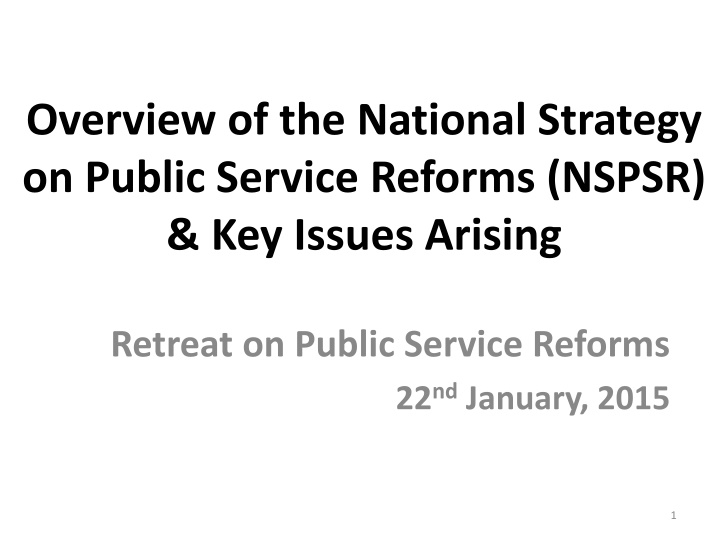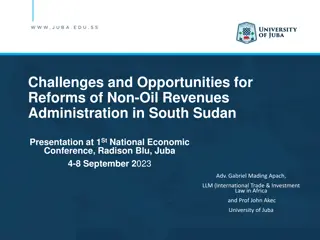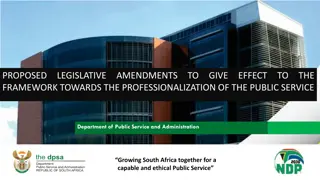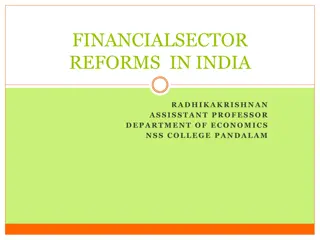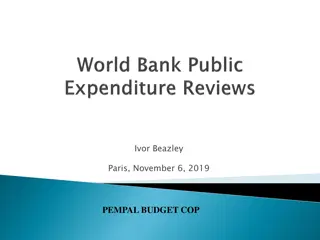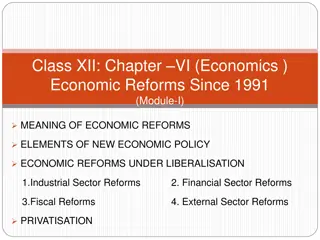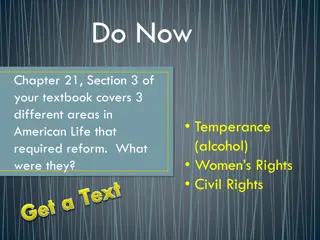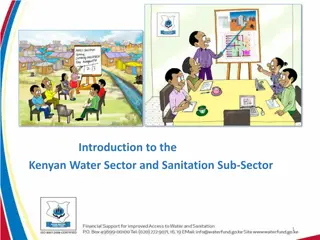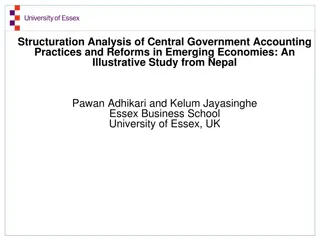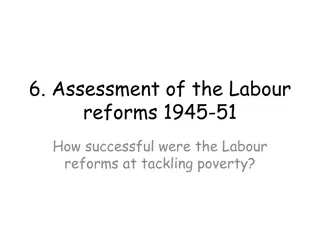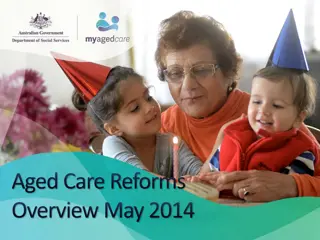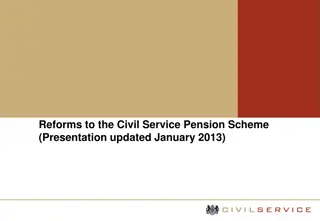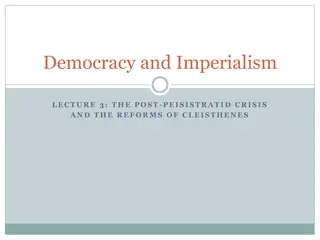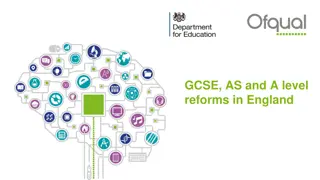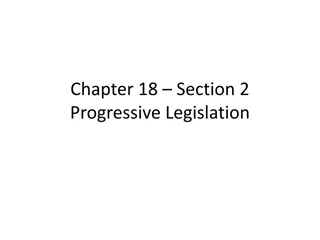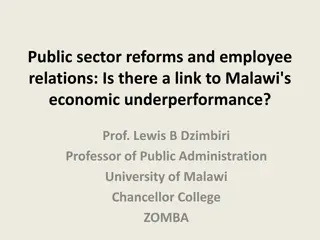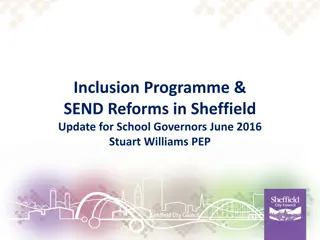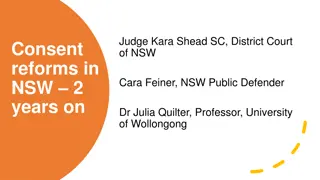National Strategy on Public Service Reforms Overview
This overview presents the National Strategy on Public Service Reforms, detailing the pillars and long-term goals to transform public services in Nigeria by 2025. It highlights key areas such as governance, social and economic development, and institutional improvements across various government agencies.
Uploaded on Apr 04, 2025 | 1 Views
Download Presentation

Please find below an Image/Link to download the presentation.
The content on the website is provided AS IS for your information and personal use only. It may not be sold, licensed, or shared on other websites without obtaining consent from the author.If you encounter any issues during the download, it is possible that the publisher has removed the file from their server.
You are allowed to download the files provided on this website for personal or commercial use, subject to the condition that they are used lawfully. All files are the property of their respective owners.
The content on the website is provided AS IS for your information and personal use only. It may not be sold, licensed, or shared on other websites without obtaining consent from the author.
E N D
Presentation Transcript
Overview of the National Strategy on Public Service Reforms (NSPSR) & Key Issues Arising Retreat on Public Service Reforms 22ndJanuary, 2015 1
National Strategy for Public Service Reform Long Term Perspective All MDAs achieve this by 2025 World class PHASE THREE All MDAs achieve this by 2020 Transforming PHASE TWO All MDAs achieve this by 2017 Reinvigorating 2 PHASE ONE
Pillar Structure Pillar One Pillar 1: wider enabling governance environment Pillar 2: reflects the strategic thrust of the Transformation Agenda, to achieve overall social and economic development of Nigeria Pillars 3 and 4: more internally focused on the workings of the public service Pillar 2 Pillar One Pillar One Pillar 3 Pillar 4 Pillar One 3
Pillar One World Class by 2025 A well functioning federal system is institutionalised Zero tolerance for corruption Transformed by 2020 High degree of cooperation between Federal and State governments in improving service delivery. Level of responsiveness to requests under the FOI Nigeria s ranking on Transparency International Corruption Perception Index significantly improved Safety and security environment encourages growth and development Constitution and other legislative changes streamline IGR and clarify roles, structures and accountabilities in public service administration. Revised Public Service Rules and Regulations in use. Decision made on need for new Public Service Act and the new Act in use . Full financial independence of a justice system. Increased collaboration between the Police and other security agencies to contain insurgencies and crime. BPSR is ensuring effective coordination of NSPSR implementation Reinvigorated by 2017 4
Pillar Two Socio-economic performance sustained on Vision 20-2020 projections. . World Class by 2025 Nigeria s economy comparable to those of G20 countries. Single digit national unemployment rate achieved. Demonstrated increase in domestic and foreign investments in infrastructural facilities. Local government authorities' capacity for planning and plan implementation strengthened. A National Social Security Policy (NSSP) developed and implemented. Capacity to regulate PPP built and strengthened. Relevant international laws, treaties, etc. domesticated Transformed by 2020 An integrated rural development strategy developed and implemented. A system for continuous research and M&E of policy outcomes and impact installed in NPC. Reform and privatisation of the power sector fast tracked. Appropriate policies and guidelines for PPPs in non-infrastructure sectors developed and implemented. The National Action Plan on Employment Creation (NAPEC) fully implemented. Reinvigorated by 2017 5
Pillar Three World Class by 2025 Macroeconomic & fiscal frameworks at level of top 20 economies VFM audits across all MDAs/ major programmes and shared with NASS Transformed by 2020 FG & 60% + of State Governments comply with FRA Sections 81(1), 82 and 59 of the Constitution amended GIFMIS interfaced with all key PFM systems including IPPIS, CS-DRMS, FIRS, Customs, NNPC and DPR for efficient management of resources, accounting and reporting VFM audits conducted in MDAs by internal audit units and OAuGF Fiscal Responsibility Act reviewed and amended New Finance Control and Management Act is in place Budget Calendar with responsible entities for each activity approved and in use Programme Segment of the NCOA completed and in use Treasury Single Account (TSA) system operational and ensures effective funds management and controls across all MDAs Reinvigorated by 2017 6
Pillar Four World Class by 2025 Best and brightest graduates are proud to work in the civil service MDA performance is comparable to top 20 economies Majority of MDAs have excellent working environment Transformed by 2020 IPPIS extended to all MDAs Discipline is effectively restored throughout the civil service All MDAs implement plans for improved organisational performance Civil service pay levels comparable to top 5 African economies & reviewed periodically Bureaucracy in service delivery minimised with delegation of functions Leadership role of the OHCSF is clarified and strengthened IPPIS extended to substantial number of MDAs Competitive pay to attract and retain the best and brightest is in place. Merit principle, with due cognisance of FC principle, is effectively restored Training of civil servants is policy-driven and needs-based An effective performance management system is installed and implemented Reinvigorated by 2017 7
Pillar One Overarching Public Service Administration Issues What NSPSR says Clarification of FCSC/FCC interface consistent with 1999 Constitution Clarification of institutional responsibility for coordination and supervision of parastatals Implement recommendations of Presidential Committee on Restructuring and Rationalisation of Federal Government Parastatals, Commissions and Agencies Review the need for a Federal Public Service Act Regular revision of the Public Service Rules and Regulations What do we need to discuss? How do we better manage parastatal service delivery? How can parent Ministries and Parastatals be better aligned? Are Parastatals aligned with the Transformation Agenda ? Do we need a Public Service Act? 8
Pillar One Accountability and Service Delivery What NSPSR says Strengthen accountability of government to the citizens Empower CSOs as watchdogs over public service issues. Sensitize public about rights to service delivery entitlements. Develop a Charter Mark Scheme Build citizen participation into policy and delivery processes What do we need to discuss? How can SERVICOM be made more effective? How can we make MDAs more customer focused? How do we enhance participation in monitoring and feedback? 9
Pillar Two Public Private Partnerships What NSPSR says Ensure strong Public-Private Partnerships in the delivery of public goods and services PPPs wider than infrastructure sector (agriculture, education and health) Policy and guidelines for non-infrastructure PPPs Develop competencies and attitudes of public servants in PPP management Building capacities for monitoring performance of PPP contracts What do we need to discuss? How can PPPs be scaled up to help cope with declining public revenues for investment? How can public service capacity be improved to manage PPPs?
Pillar Three Budgeting What NSPSR says Enhance compact between NASS and Executive in budget process. Sustain improvements in budget formulation and monitoring Implement performance-based budgeting system Enhance capacity for result-based budgeting Harmonise planning and budgeting processes to link policy, plan and budget. More effective MTFF, MTEF and FSP, which are linked to each other and to the budget What do we need to discuss? How can we best fast- track adoption and implementation of a budget calendar? What solutions are there to executive - legislative budget deadlocks? How can NPC and Budget Office link plans and budgets better? What changes/ improvements can be made to MTEF? 11
Pillar Three Procurement Reform What do we need to discuss? How can transparency in procurement process be improved? How do we stop contract splitting and variation? How can procurement capacity be developed in MDAs? What NSPSR says Implement the Public Procurement Act and subsidiary rules and procedures fully BPP to design and implement a procurement system that ensures public access to procurement information to enhance transparency and accountability BPP to step up procurement reviews, audits, and field monitoring of ongoing projects and apply appropriate sanctions to violations BPP to intensify awareness raising efforts to enhance understanding of the provisions of the Public Procurement Act
Pillar Four Salaries What NSPSR says Collaboration between institutions responsible for pay of public servants and political office holders, to ensure relativity Medium term pay reform to recruit and motivate quality and professional staff Periodical pay reviews Improve NSIWC capacity to manage job evaluations Strategy for comprehensive job evaluation across the service, to ensure equity What do we need to discuss? How can salary discrepancies between levels/organisations be addressed? How can discrepancies in emolument between political office holders and non- political office holders be addressed? 13
Pillar Four Performance Management What NSPSR says Link institutional, departmental and individual performance measures KPIs cascaded through Ministers, PSs/Directors to staff Collaborative targets, to reduce patronage and favouritism Make staff appraisals central to upwards mobility Reform incentives to enable quality and professional staff be recruited and motivated What do we need to discuss? How do we make appraisal system more rigorous and effective? How do we link incentives and rewards to good performance? 14
